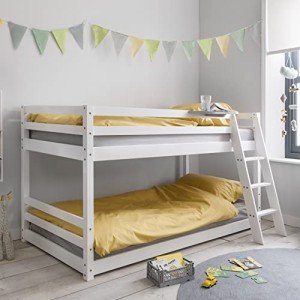A Comprehensive Guide to Children's Bunk Beds: Styles, Benefits, and Safety Considerations
Bunk beds have become a popular choice for families wanting to make the most of space and provide a fun sleeping environment for children. With their unique style, they use an imaginative and useful solution for shared bedrooms, playrooms, and even guest lodging. This post explores the various designs of children's bunk beds, their benefits, security factors to consider, and answers some often asked concerns.
The Allure of Bunk Beds
Kid's bunk beds are more than simply space-saving structures; they are also an entrance to adventurous dreams and creative play. Below is a comprehensive examination of their various advantages.
Benefits of Bunk Beds
- Space-Saving: Bunk beds efficiently make use of vertical space, making them an ideal option for smaller sized rooms.
- Lively Design: Many bunk bed designs consist of slides, tents, and themed components, stimulating imagination and enjoyment.
- Partner Sharing: Bunk beds are best for brother or sisters sharing a room or accommodating pajama parties.
- Flexible Use: Some models can be separated into 2 private beds, using flexibility as children grow.
- Storage Options: Many bunk beds include integrated drawer storage or shelves, further boosting their practicality.
Designs of Children's Bunk Beds
The range of bunk beds readily available today deals with various preferences and needs. Below is an overview of some popular styles.
| Style | Description | Best For |
|---|---|---|
| Standard Bunk Bed | A traditional design featuring one bed stacked above another. | Brother or sisters sharing a room. |
| Loft Bed | Similar to a bunk bed without the bottom bunk, enables a work area or play area listed below. | Minimal space for play/desk. |
| L-Shaped Bunk Bed | 2 beds arranged in an L-shape, typically with extra areas for storage or play. | Special space designs. |
| Twin Over Full | A twin bed over a complete bed, accommodating various sleep requirements. | Growing kids and teens. |
| High Sleeper | Stands even higher than a loft bed, generally including a desk or play area below. | Older kids requiring more play/desk space. |
| Tent Bunk Bed | Bunk beds with a canopy or tent-like structure, developing a cozy, enjoyable space. | Active and imaginative kids. |
Secret Features to Consider
When choosing the best bunk bed for children, the following functions deserve thinking about:
- Material: Bunk beds can be made from wood, metal, or a mix. Each has its special aesthetic and toughness.
- Weight Capacity: Always validate the weight limitation of the bunk bed to guarantee it can accommodate your children safely.
- Security Rails: Ensure the leading bunk has strong rails to avoid falls.
- Ladder Security: A well-designed ladder should use simple and safe access to the upper bunk.
- Completing: Ensure any surfaces are non-toxic and safe for children.
Security Considerations
Security is vital when it pertains to children's bunk beds. The following standards must be followed:
- Age Appropriateness: Generally, children under 6 years of ages must not sleep in the upper bunk due to security threats.
- Strong Construction: Ensure the frame and products are solid and can support the weight without drooping.
- Routine Maintenance: Periodically check for loose screws, bolts, or other elements that may need tightening up.
- Clear Play Area: Keep the area around the bunk bed totally free of toys and barriers to decrease tripping hazards.
Setting Rules for Safe Use
Developing guidelines for bunk bed use will assist guarantee security:
- Limit Jumping and Climbing: Children must be recommended against jumping from the top bunk and climbing up on the sides.
- Monitoring Sleepovers: Monitor young visitors while they are using the bunk bed for the very first time.
- Inform on Ladder Use: Teach how to utilize the ladder safely, stressing the value of facing the ladder when climbing or down.
Frequently Asked Questions
1. What age is appropriate for a kid to oversleep the leading bunk?
Most producers advise that kids should be at least six years of ages to oversleep the upper bunk. This standard is designed to mitigate the threat of falls.
2. Can bunk beds be tailored?
Yes, many manufacturers offer customizable options, including colors, products, and additional features like drawers or desks.
3. Are bunk beds safe for weight?
Bunk beds have weight limitations, typically ranging from 200 to 400 pounds, depending upon the model and product. Constantly check the manufacturer's requirements.
4. How do I preserve and clean up a bunk bed?
Regularly look for loose parts, keep the bed clean by wiping down surface areas, and make sure the bedding is fresh to promote a safe and sanitary sleep environment.
5. Can bunk beds be separated into specific beds?
Lots of bunk beds feature a choice to separate them into two individual beds, supplying long-lasting adaptability.
Children's bunk beds are more than simple furniture; they are a functional, flexible, and imaginative component of a child's room. With numerous styles readily available and various security considerations to keep in mind, parents can choose the best bed that fits their space, satisfies their kids's needs, and instills a sense of adventure. By comprehending Sale Bunk Bed , designs, and precaution connected with bunk beds, households can produce a delightful and safe sleeping environment for their children. Whether for siblings sharing a room or space-saving options, bunk beds remain a beloved option for lots of families.

